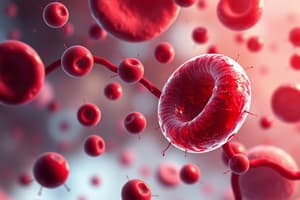Podcast
Questions and Answers
What component of blood represents the matrix?
What component of blood represents the matrix?
- Blood platelets
- Red blood corpuscles
- Plasma (correct)
- White blood cells
Which type of leukocytes includes neutrophils, eosinophils, and basophils?
Which type of leukocytes includes neutrophils, eosinophils, and basophils?
- Red blood corpuscles
- Agranular leukocytes
- Granular leukocytes (correct)
- Platelets
What is the average lifespan of red blood corpuscles?
What is the average lifespan of red blood corpuscles?
- 90-100 days
- 70-80 days
- 130-150 days
- 100-120 days (correct)
What is the primary function of hemoglobin in red blood corpuscles?
What is the primary function of hemoglobin in red blood corpuscles?
What staining method is commonly used to differentiate blood cells?
What staining method is commonly used to differentiate blood cells?
Which constituent of red blood corpuscles is responsible for their flexibility?
Which constituent of red blood corpuscles is responsible for their flexibility?
What percentage of the corpuscular volume does hemoglobin occupy in red blood corpuscles?
What percentage of the corpuscular volume does hemoglobin occupy in red blood corpuscles?
Which type of leukocyte is absent of granules?
Which type of leukocyte is absent of granules?
What characteristic shape do red blood corpuscles have that increases their surface area for gas exchange?
What characteristic shape do red blood corpuscles have that increases their surface area for gas exchange?
What is the typical count range for red blood corpuscles in females?
What is the typical count range for red blood corpuscles in females?
Flashcards
Blood Composition
Blood Composition
Blood is a connective tissue composed of plasma (the matrix) and formed elements (cells).
Formed Blood Elements
Formed Blood Elements
The cells within blood, including red blood cells, white blood cells, and platelets.
Red Blood Cells (RBCs)
Red Blood Cells (RBCs)
Responsible for oxygen transport due to hemoglobin; have a biconcave shape.
RBC Shape
RBC Shape
Signup and view all the flashcards
RBC Nucleus
RBC Nucleus
Signup and view all the flashcards
Hemoglobin
Hemoglobin
Signup and view all the flashcards
RBC Life Span
RBC Life Span
Signup and view all the flashcards
Blood Smear Staining
Blood Smear Staining
Signup and view all the flashcards
Blood Count
Blood Count
Signup and view all the flashcards
RBC Count Average
RBC Count Average
Signup and view all the flashcards
Study Notes
Blood Composition and Structure
- Blood is a specialized connective tissue composed of plasma (the matrix) and formed elements (the cells).
- It lacks fibers.
- Formed elements include red blood cells (RBCs), white blood cells (WBCs), and platelets.
- WBCs are further categorized into granular (neutrophils, eosinophils, basophils) and agranular (lymphocytes, monocytes).
Blood Cell Differentiation
- Giemsa stain (methylene blue + eosin) is used to differentiate blood cells based on their nuclei and cytoplasmic granules.
- Basophilic (violet)
- Eosinophilic (pink)
- Azurophilic (red-purple)
Blood Counts
- Blood counts determine the average number of formed elements per cubic millimeter of blood.
- RBC count
- Total leukocytic count
- Platelet count
- Differential leukocytic count (percentage of each white blood cell type).
- Normal RBC counts:
- Males: 5-5.5 million/mm³
- Females: 4.5-5 million/mm³
- Lifespan of RBCs: 100-120 days. Old/deformed RBCs are removed by macrophages in the spleen and liver.
Red Blood Cell (RBC) Characteristics
- Structure (LM): Biconcave discs, 7.2-7.8 µm diameter (fits smallest capillaries), no nucleus, hemoglobin (33% volume) concentrated peripherally
- Structure (EM): Membranous electron dense biconcave discs, no organelles, no nucleus.
- RBC Membrane:
- Outer glycocalyx: Responsible for blood grouping.
- Inner cytoskeleton: composed of microfilaments (actin & spectrin), anchored to membrane proteins (ankyrin), enables flexibility.
- Adaptation to function:
- Biconcave shape: Increases surface area (20-30%) for gas exchange.
- Lack of nucleus/organelles: Maximizes hemoglobin carrying capacity.
- Peripheral hemoglobin concentration: Facilitates oxygen/carbon dioxide binding.
- Cytoskeleton structure: Allows RBCs to navigate narrow capillaries.
- Selective membrane permeability: Enhances gas diffusion during exchange.
Function of Red Blood Cells
- Contain hemoglobin for gas exchange.
Studying That Suits You
Use AI to generate personalized quizzes and flashcards to suit your learning preferences.




